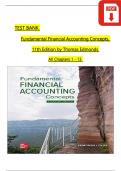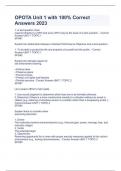TEST BANK
Fundamental Financial Accounting Concepts,
11th Edition by Thomas Edmonds
All Chapters 1 - 13
, TABLE OF CONTENTS
Chapter 1 An Introduction to Accounting
Chapter 2 Accounting for Accruals and Deferrals
Chapter 3 The Double-Entry Accounting System
Chapter 4 Accounting for Merchandising Businesses
Chapter 5 Accounting for Inventories
Chapter 6 Internal Control and Accounting for Cash
Chapter 7 Accounting for Receivables
Chapter 8 Accounting for Long-Term Operational Assets
Chapter 9 Accounting for Current Liabilities and Payroll
Chapter 10 Accounting for Long-Term Debt
Chapter 11 Proprietorships, Partnerships, and Corporations
Chapter 12 Statement of Cash Flows
Chapter 13 Financial Statement Analysis (Available online in Connect)
,Chapter 1 An Introduction to Accounting
1) Indicate whether each of the following statements about markets is true or false.
a) Financial resources can be provided to a business by investors.
b) Resource owners are the businesses that transform resources into
products that satisfy consumer desires.
c) Labor resources include both the physical and intellectual labor of a
business's employees.
d) Businesses purchase their resources from resource owners.
e) Consumers are the main providers of resources in any market.
2) Indicate whether each of the following statements about accounting information
is true or false.
a) Financial accounting is primarily intended to satisfy the information
needs of internal stakeholders.
b) Managerial accounting information includes financial and
nonfinancial information.
c) The accounting information intended to satisfy the needs of a
company's employees is managerial accounting information.
d) GAAP requires that companies adhere to financial accounting standards.
e) Managerial accounting information is usually less detailed than
financial accounting information.
3) Indicate whether each of the following statements about liabilities is true or false.
a) A net loss on the income statement decreases liabilities.
b) The acquisition of a bank loan increases both assets and liabilities.
c) The accounting equation requires that liabilities be equal to stockholders’ equity.
d) The amount of a company's liabilities is equal to the difference between
its assets and its stockholders’ equity.
e) Liabilities are reported on the statement of cash flows of a business.
,4) Indicate whether each of the following statements about retained earnings is true or
false.
a) A dividend paid to stockholders decreases retained earnings.
b) Issuing common stock for cash increases retained earnings.
c) The amount of net income for a period must equal retained earnings.
d) The purchase of a truck decreases retained earnings.
e) Net income increases retained earnings.
5) Indicate whether each of the following statements about the types of
transactions is true or false.
a) An asset source transaction increases total assets and increases claims to assets.
b) The issuance of stock to owners for cash would be an example of
an asset exchange transaction.
c) Purchasing equipment for cash is an example of an asset use transaction.
d) Paying a dividend to stockholders is an example of an asset use transaction.
e) Making a payment on a bank loan is an example of an asset exchange
transaction.
6) Indicate whether each of the following statements about financial statements
is true or false.
a) A cash dividend paid to stockholders is reported in the investing activities
section of the statement of cash flows.
b) A cash dividend paid to stockholders is reported on the statement of
changes in stockholders' equity.
c) A cash dividend paid to stockholders is reported on the income statement.
d) The balance sheet reports the ending balances of permanent accounts as
of the last day of the accounting period.
e) Changes in retained earnings during the accounting period are
reported on the income statement.
,7) Indicate whether each of the following statements about stockholders’ equity
is true or false.
a) Expenses decrease retained earnings.
b) Stockholders' equity and liabilities can be viewed either as sources of
assets or claims to assets of the business.
c) Retained earnings is increased by loans received from a bank.
d) Dividends paid to stockholders decrease common stock.
e) Generally, assets are reported at the actual price paid for them when
purchased regardless of subsequent changes in market value.
8) Jessup Company was founded in Year 1. It acquired $45,000 cash by issuing
stock to investors and an additional $15,000 cash by borrowing from creditors. During
Year 1 it received
$25,000 cash revenues and paid $32,000 in cash expenses. The company then went
out of business.
Required:
a) Explain the term, "business liquidation."
b) What amount of cash should Jessup Company have had on hand immediately
before going out of business?
c) What amount of cash will Jessup's creditors receive?
d) What amount of cash will Jessup's stockholders receive?
9) Bates Company entered into the following transactions during its first year in
business. Assume that all transactions involve the receipt or payment of cash.
1) Issued common stock to investors for $25,000 cash.
2) Borrowed $18,000 from the local bank.
3) Provided services to customers for $28,000.
4) Paid expenses amounting to $21,400.
5) Purchased a plot of land costing $22,000.
6) Paid a dividend of $15,000 to its stockholders.
7) Repaid $12,000 of the loan listed in item 2.
Required:
(a) Fill in the three column headings of the accounting equation in the first row of
,the table shown below.
(b) Show the effects of the above transactions on the accounting equation.
,Event number = +
1.
2.
3.
4.
5.
6.
7.
Total
10) Each of the following requirements is independent of the others.
a) Valdez Corporation has liabilities of $95,000 and stockholders’ equity of $115,000.
What is the amount of Valdez's assets?
b) Global Company has assets of $320,000 and liabilities of $95,000. What is the
amount of Global's stockholders’ equity?
c) Brown Company has assets of $90,000 and liabilities of $25,000. What is the amount of
Brown's claims?
,1) The following business events occurred for Ringgold Company during Year 1,
its first year in operation:
1. Issued stock to investors for $45,000 cash
2. Borrowed $25,000 cash from the local bank
3. Provided services to its customers and received $32,000 cash
4. Paid expenses of $28,000
5. Paid $22,000 cash for land
6. Paid dividend of $12,000 to stockholders
7. Repaid $10,000 of the loan listed in item 2
Required:
a) Show the effects of the above transactions on the accounting equation, below.
Include dollar amounts of increases and decreases. Enter "NA" for elements of the
accounting equation that are not affected by the transaction. If one element of the
accounting equation is affected by an increase and also by a decrease, enter each part
on a separate line. (The effects of the first transaction is shown below.)
b) After entering all the events, calculate the total amounts of assets,
liabilities, and stockholders’ equity at the end of the year.
Event Assets = Liabilities + Stockholders'
number Equity
1. 45,000 NA 45,000
2.
3.
4.
5.
6.
7.
Total
,12) Ramirez Company experienced the following events during Year 1:
1. Acquired $50,000 cash by issuing common stock
2. Borrowed $25,000 cash from a creditor
3. Provided services to customers for $38,000 cash
4. Paid $32,000 cash for operating expenses
5. Paid a cash dividend of $2,500 to stockholders
6. Purchased land with cash, $30,000
Required:
a) Show how each of these events affects the accounting equation. Enter "NA" for
elements of the accounting equation that are not affected by the transaction. If one
element of the accounting equation is affected by an increase and also by a decrease,
enter each part on a separate line. (The effects of the first event are shown below.)
b) Calculate the total amount of assets, liabilities, common stock, and retained
earnings at the end of the period.
Stockholders' Equity
Event Assets = Liabilities + Common + Retained
number Stock Earnings
1. 50,000 NA 50,000 NA
2.
3.
4.
5.
6.
Total
, 13) At the beginning of Year 2, the accounting records of Grace Company
included the accounts and balances shown on the first row of the table below. During
Year 2, the following transactions occurred:
1. Received $95,000 cash for providing services to customers
2. Paid salaries expense, $50,000
3. Purchased land for $12,000 cash
4. Paid $4,000 on note payable
5. Paid operating expenses, $22,000
6. Paid cash dividend, $2,500
Required:
a) Record the transactions in the appropriate accounts. Record the amounts of revenue,
expense, and dividends in the retained earnings column. Enter 0 for items not affected.
Provide appropriate titles for these accounts in the last column of the table.
Event Assets = Liabilities + Stockholders' Equity Account
Cash Land Notes Commo + Retained Titlesfor
Payable n Earnings RE
Stock
Beginning 29,000 32,000 18,000 33,000 10,000
1.
2.
3.
4.
5.
6.
b) What is the amount of total assets as of December 31, Year 2?
c) What is the amount of total stockholders' equity as of December 31, Year 2?





